Towing Tips: 2022 Toyota 86 Emergency Flashers User Manual
The 2022 Toyota 86 is outfitted with several emergency measures and instruments to guarantee drivers’ comfort and safety in unanticipated circumstances. To deal with unforeseen difficulties on the road, it’s essential to know how to use emergency towing, the emergency tire puncture repair kit and tools, and the Emergency Start feature. We will give thorough operation instructions for these emergency features in this handbook so that Toyota 86 owners may handle emergency circumstances with confidence. This book will show you how to handle each scenario and safely get back on the road, whether you’re dealing with a dead battery, a tire puncture, or a breakdown.
2023 Toyota GR86 Specs, Price, Features and Mileage (Brochure)
Emergency flashers
The emergency flashers are used to warn other drivers when the vehicle has to be stopped on the road due to a breakdown, etc.
Operating instructions
Press the switch. All the turn signal lights will flash. To turn them off, press the switch once again
Emergency flashers
If the emergency flashers are used for a long time while the engine is not operating, the battery may discharge.
If your vehicle has to be stopped in an emergency
Only in an emergency, such as if it becomes impossible to stop the vehicle in the normal way, stop the vehicle using the following procedure
2022 Toyota 86 User Manual
Stopping the vehicle
- Steadily step on the brake pedal with both feet and firmly depress it.
- Do not pump the brake pedal repeatedly as this will increase the effort required to slow the vehicle.
- Shift the shift lever to N.
- If the shift lever is shifted to N
- After slowing down, stop the vehicle in a safe place by the road.
- Stop the engine.
- If the shift lever cannot be shifted to N
- Keep depressing the brake pedal with both feet to reduce vehicle speed as much as possible.
- To stop the engine, press and hold the engine switch for 2 consecutive seconds or more, or press it briefly 3 times or more in succession Stop the vehicle in a safe place by the road.
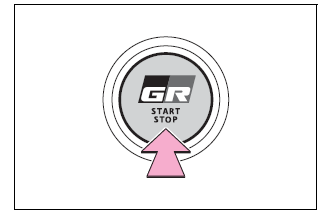
WARNING
If the engine has to be turned off while driving Power assist for the brakes and steering wheel will be lost, making the brake pedal harder to depress and the steering wheel heavier to turn. Decelerate as much as possible before turning off the engine.
If the vehicle is submerged or water on the road is rising
This vehicle is not designed to be able to drive on roads that are deeply flooded with water. Do not drive on roads where the roads may be submerged or the water may be rising. It is dangerous to remain in the vehicle if it is anticipated that the vehicle will be flooded or set a drift. Remain calm and follow the following.
- If the door can be opened, open the door and exit the vehicle.
- If the door cannot be opened, open the window using the power window switch and ensure an escape route.
- If the window can be opened, exit the vehicle through the window.
- If the door and window cannot be opened due to the rising water, remain calm, wait until the water level inside the vehicle rises to the point that the water pressure inside of the vehicle equals the water pressure outside of the vehicle, and then open the door after waiting for the rising water to enter the vehicle, and exit the vehicle. When the outside water level exceeds half the height of the door, the door cannot be opened from the inside due to water pressure.
The water level exceeds the floor
When the water level exceeds the floor and time has passed, the electrical equipment will get damaged, the power windows will not operate, the engine stop, and the vehicle may not be able to get moving.
Using an emergency escape hammer*
- Laminated glass is used in the windshield of this vehicle.
- Laminated glass cannot be shattered with an emergency hammer*.
- Tempered glass is used in the windows of this vehicle.
Contact your Toyota dealer or aftermarket accessory manufacturer for further information about an emergency hammer.
WARNING
- Caution while driving
- Do not drive on roads where the roads may be submerged or the water may be rising.
- Otherwise, the vehicle may be damaged and cannot move, as well as become flooded and set a drift, which may lead to death.
If your vehicle needs to be towed
If towing is necessary, we recommend having your vehicle towed by your Toyota dealer or commercial towing service, using a wheel-lift type truck or flatbed truck. Use a safety chain system for all towing, and abide by all state/provincial and local laws. If towing your vehicle with a wheel-lift type truck from the front, the vehicle’s rear wheels and axles must be in good condition. (P.342) If they are damaged, use a towing dolly or flatbed truck.
Car problems solutions
WARNING
Observe the following precautions. Failure to do so may result in death or serious injury
If your vehicle needs to be towed
If towing is necessary, we recommend having your vehicle towed by your Toyota dealer or commercial towing service, using a wheel-lift type truck or flatbed truck. Use a safety chain system for all towing, and abide by all state/provincial and local laws.
When towing the vehicle
- Be sure to transport the vehicle with all four wheels raised off the ground. If the vehicle is towed with the tires contacting the ground, the drivetrain and related parts may be damaged or an accident may occur due to a change in direction of the vehicle.

While towing
Installing towing eyelets to the vehicle
- Make sure that towing eyelets are installed securely. If not securely installed, towing eyelets may come loose during towing.
2022 Toyota 86 Owners Manual
WARNING
- After towing
- Make sure to remove the towing eyelet.
- If not removed, the SRS airbags may not deploy correctly if the vehicle is involved in a frontal collision, or the fuel pump shutoff system may not operate correctly
- if involved in a rear collision.
NOTICE
- To prevent damage to the vehicle when towing using a wheel-lift type truck
- Do not tow the vehicle from the rear when the engine switch is off. The steering lock mechanism is not strong enough to hold the front wheels straight.
- When raising the vehicle, ensure adequate ground clearance for towing at the opposite end of the raised vehicle. Without adequate clearance, the vehicle could be damaged while being towed.
- To prevent damage to the vehicle when towing with a sling-type truck
- Do not tow with a sling-type truck, either from the front or rear.
- To prevent damage to the vehicle during emergency towing
- Do not secure cables or chains to the suspension components.
- When towing down a long slope
- Use a wheel lift-type or flatbed truck.
- If a wheel lift-type or flatbed truck is not used, the brakes may overheat, leading to poor brake performance.
Situations when it is necessary to contact dealers before towing
The following may indicate a problem with your transmission. Contact your Toyota dealer or commercial towing service before towing.
- The engine is running but the vehicle does not move.
- The vehicle makes an abnormal sound.
Towing with a wheel-lift type truck
From the front
Use a towing dolly under the rear wheels.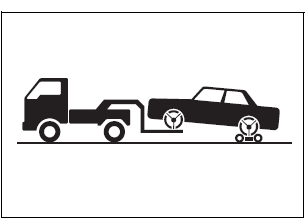
From the rear
Use a towing dolly under the front wheels.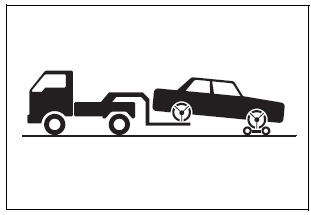
NOTICE
Towing with a sling-type truck Do not tow with a sling-type truck to prevent body damage.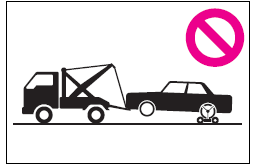
Using a flatbed truck
When using a flatbed truck to transport the vehicle, use tire strapping belts. Refer to the owner’s manual of the flatbed truck for the tire strapping method.
To suppress vehicle movement during transportation, set the parking brake and turn the engine switch off.
2022 Toyota 86 User Guide
Emergency towing
Emergency car information
If a tow truck is not available in an emergency, your vehicle may be temporarily towed using cables or chains secured to the emergency towing hooks. This should only be attempted on hard-surfaced roads for at most 50 miles (80 km) at under 18 mph (30 km/h). A driver must be in the vehicle to steer and operate the brakes. The vehicle’s wheels, drive train, axles, steering, and brakes must be in good condition.
Emergency towing procedure
To have your vehicle towed by another vehicle, the towing eyelet must be installed on your vehicle. Install the towing eyelet using the following procedure.
- Take out the wheel nut wrench, flathead screwdriver, and towing eyelet. (P.359)
- Remove the eyelet cover using a flathead screwdriver.
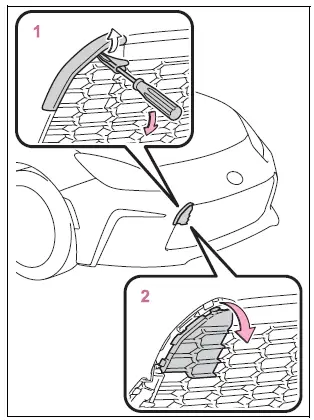
- Remove the upper cover from the bumper
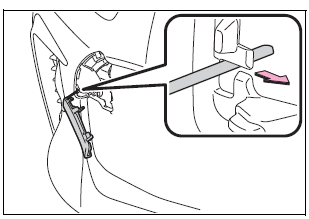
- Remove the lower cover from the bumper

- Insert the towing eyelet into the hole and tighten it partially by hand.
- Tighten down the towing eyelet securely using a wheel nut wrench or hard metal bar.
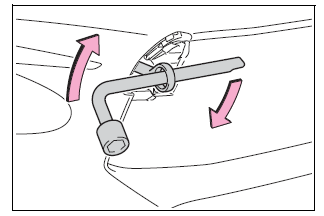
- Securely attach cables or chains to the towing eyelet
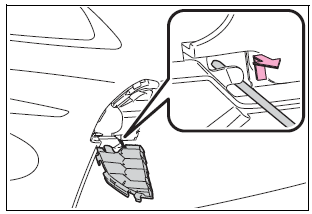
- Enter the vehicle being towed and start the engine.
- Shift the shift lever to N and release the parking brake
Towing eyelet purpose
The towing eyelet is to be used to tow your vehicle, not to tow other vehicles.
While towing
If the engine is not running, the power assist for the brakes and steering will not function, making steering and braking more difficult.
Wheel nut wrench
A wheel nut wrench is installed in the trunk. (P.359)
Rear towing eyelet
If the towing eyelet is installed to the rear, it can be used in an emergency to tow a vehicle lighter than your vehicle on a normal road, using a rope.
When towing another vehicle
For vehicles with BSD/RCTA, make sure to turn BSD/RCTA off. As the radar waves will be blocked by the towed vehicle, this system will not operate properly.
When installing a towing eyelet to the rear
When installing a towing eyelet to the rear, install it using the following procedure.
- Take out the wheel nut wrench, flathead screwdriver, and towing eyelet.
- Remove the eyelet cover using a flathead screwdriver.
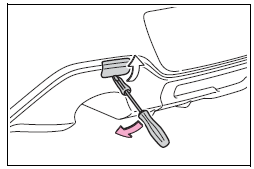
- Remove the cover from the bumper.
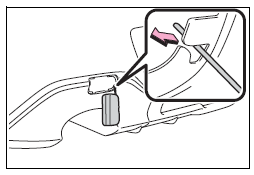
- Insert the towing eyelet into the hole and tighten it partially by hand.
- Tighten down the towing eyelet securely using a wheel nut wrench or hard metal bar.
If you think something is wrong
If you notice any of the following symptoms, your vehicle probably needs adjustment or repair. Contact your Toyota dealer as soon as possible.
Visible Symptoms
- Fluid leaks under the vehicle.
(Water dripping from the air conditioning after use is normal.) - Flat-looking tires or uneven tire wear
- The engine coolant temperature gauge needle continually points higher than normal.
Audible symptoms
- Changes in exhaust sound
- Excessive tire squeal when cornering
- Strange noises related to the suspension system
- Pinging or other noises related to the engine
Operational symptoms
- Engine missing, stumbling, or running roughly
- Appreciable loss of power
- The vehicle pulls heavily to one side when braking
- Vehicle pulls heavily to one side when driving on a level road
- Loss of brake effectiveness, spongy feeling, pedal almost touches the floor
Fuel pump shut-off system
When the vehicle sustains an impact in an accident, etc., the fuel pump shut-off system operates to stop supplying fuel to minimize fuel leakage.
NOTICE
Before starting the engine
Inspect the ground under the vehicle. If you find that fuel has leaked onto the ground, the fuel system has been damaged and needs repair. Do not restart the engine.
If a warning light turns on or a warning buzzer sounds
Calmly perform the following actions if any of the warning lights come on or flash. If a light comes on or flashes, but then goes off, this does not necessarily indicate a malfunction in the system. However, if this continues to occur, have the vehicle inspected by your Toyota dealer.
Actions to the warning lights or warning buzzers
- Brake system warning light (warning buzzer)
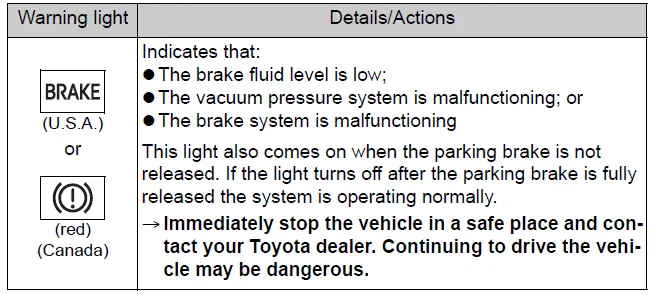
- High coolant temperature warning light (warning buzzer)

- Charging system warning light

- Low engine oil pressure warning light

- Malfunction indicator lamp
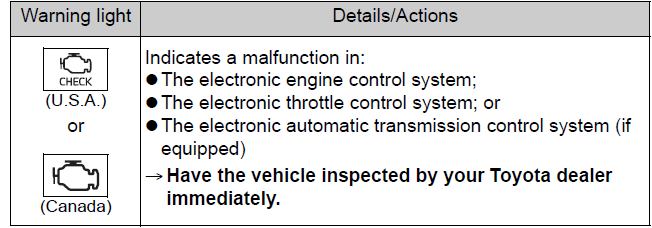
- SRS warning light (warning buzzer)

- ABS warning light (warning buzzer)
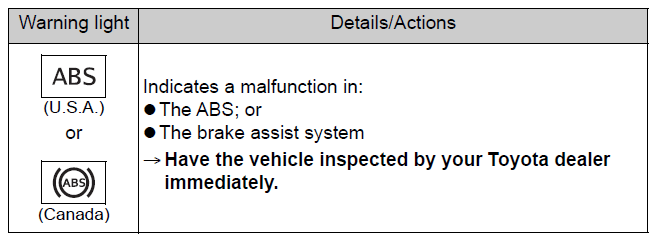
- Electric power steering system warning light (warning buzzer)

- Slip indicator (warning buzzer)
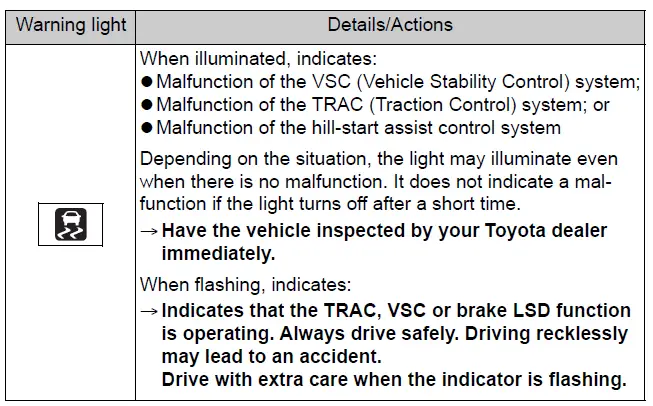
- Automatic transmission fluid temperature warning light (warning buzzer) (if equipped)
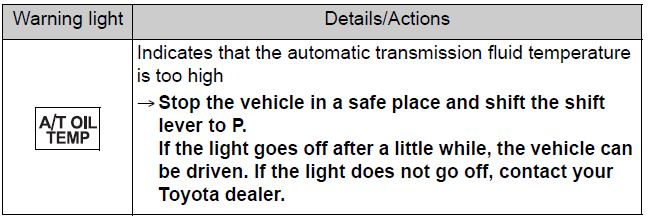
- Open door warning light
 Low fuel level warning light (warning buzzer)
Low fuel level warning light (warning buzzer)
- Driver’s and front passenger’s seat belt reminder light (warning buzzer)*1,

- The front passenger’s seat belt reminder light is located on the overhead console.
- Driver’s seat belt warning buzzer: The driver’s seat belt warning buzzer sounds to alert the driver that his or her seat belt is not fastened. Once the engine switch is turned ON, the buzzer sounds.
If the seat belt is still unfastened, the buzzer sounds intermittently for a certain period after the vehicle reaches a certain speed.
Front passenger’s seat belt warning buzzer:
The front passenger’s seat belt warning buzzer sounds to alert the front passenger that his or her seat belt is not fastened. If the seat belt is unfastened, the buzzer sounds intermittently for a certain period after the vehicle reaches a certain speed
Rear passengers’ seat belt reminder lights (warning buzzer)*1, 2
- This light illuminates the overhead console.
- Rear passengers’ seat belt warning buzzer:
The rear passenger’s seat belt warning buzzer sounds to alert the rear passenger that his or her seat belt is not fastened. If the seat belt is unfastened, the buzzer sounds intermittently for a certain period, after the vehicle reaches a certain speed.
The conventional cruise control indicator (if equipped)
BSD/RCTA warning light (if equipped) (warning buzzer)

SRH warning light (if equipped) (warning buzzer)

RAB warning light (if equipped) (warning buzzer)

LED headlight warning light (warning buzzer)

Automatic headlight leveling system warning light (warning buzzer)

Master warning light (warning buzzer)

EyeSight warning light (if equipped) (warning buzzer)

Tire pressure warning light (warning buzzer).
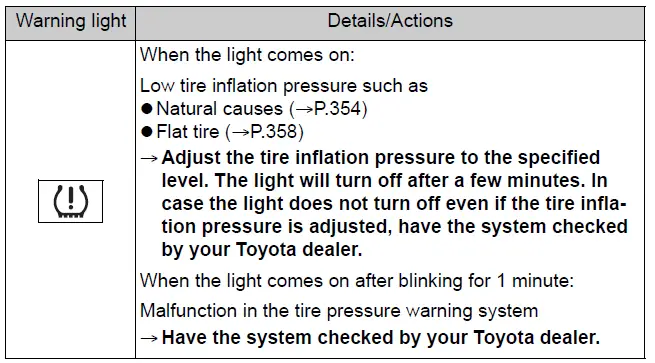
Front passenger detection sensor, seat belt reminder, and warning buzzer
- If luggage is placed on the front passenger seat, the front passenger detection sensor may cause the warning light to flash and the warning buzzer to sound even if a passenger is not sitting in the seat.
- If a cushion is placed on the seat, the sensor may not detect a passenger, and the warning light may not operate properly.
If the malfunctioning indicator lamp comes on while driving First check the following:
- Is the fuel tank empty? If it is, fill the fuel tank immediately.
- Is the fuel tank cap loose? If it is, tighten it securely. The light will go off after several driving trips. If the light does not go off even after several trips, contact your Toyota dealer as soon as possible.
- Electric power steering system warning light (warning buzzer) When the battery charge becomes insufficient or the voltage temporarily drops, the electric power steering system warning light may come on and the warning buzzer may sound.
- When the tire pressure warning light comes on Check the tire inflation pressure and adjust it to the appropriate level.
- Pushing the tire pressure warning reset switch will not turn off the tire pressure warning light.
- The tire pressure warning light may come on due to natural causes
- The tire pressure warning light may come on due to natural causes such as natural air leaks and tire inflation pressure changes caused by temperature.
- In this case, adjusting the tire inflation pressure will turn off the warning light (after a few minutes).
- Conditions that the tire pressure warning system may not function properly.
- If the tire pressure warning light frequently comes on after blinking for 1 minute If the tire pressure warning light frequently comes on after blinking for 1 minute when the engine switch is turned to ON, have it checked by your Toyota dealer.
- Warning buzzer In some cases, the buzzer may not be heard due to being in a noisy location or audio sound.
WARNING
- If both the ABS and the brake system warning lights remain on Stop your vehicle in a safe place immediately and contact your Toyota dealer. The vehicle will become extremely unstable during braking, and the ABS may fail, which could cause an accident resulting in death or serious injury.
- When the electric power steering system warning light comes on The steering wheel may become extremely heavy. When steering wheel operations are heavier than usual, grip the steering wheel firmly and operate it using more force than usual.
- If the tire pressure warning light comes on Be sure to observe the following precautions. Failure to do so could cause a loss of vehicle control and result in death or serious injury.
- Stop your vehicle in a safe place as soon as possible. Adjust the tire inflation pressure immediately. If the tire pressure warning light comes on even after tire inflation pressure adjustment, you probably have a flat tire. Check the tires. If a tire is flat, repair the flat tire by using an emergency tire puncture repair kit.
- Avoid abrupt maneuvering and braking. If the vehicle tires deteriorate, you could lose control of the steering wheel or the brakes.
- If a blowout or sudden air leakage should occur The tire pressure warning system may not activate immediately.
- Maintenance of the tires Each tire, including the spare (if provided), should be checked monthly when cold and inflated to the inflation pressure recommended by the vehicle manufacturer on the vehicle placard or tire inflation pressure label (tire and load information label). (If your vehicle has tires of a different size than the size indicated on the vehicle placard or tire inflation pressure label [tire and load information label], you should determine the proper tire inflation pressure for those tires.)
WARNING
As an added safety feature, your vehicle has been equipped with a tire pressure monitoring system (TPMS-tire pressure warning system) that illuminates a low tire pressure telltale (tire pressure warning light) when one or more of your tires is significantly under-inflated. Accordingly, when the low tire pressure telltale (tire pressure warning light) illuminates, you should stop and check your tires as soon as possible, and inflate them to the proper pressure. Driving on a significantly under-inflated tire causes the tire to overheat and can lead to tire failure. Under-inflation also reduces fuel efficiency and tire tread life and may affect the vehicle’s handling and stopping ability. Please note that the TPMS (tire pressure warning system) is not a substitute for proper tire maintenance, and it is the driver’s responsibility to maintain correct tire pressure, even if under-inflation has not reached the level to trigger illumination of the TPMS low tire pressure telltale (tire pressure warning light). Your vehicle has also been equipped with a TPMS (tire pressure warning system) malfunction indicator to indicate when the system is not operating properly. The TPMS (tire pressure warning system) malfunction indicator is combined with the low tire pressure telltale (tire pressure warning light). When the system detects a malfunction, the telltale will flash for approximately one minute and then remain continuously illuminated. This sequence will continue upon subsequent vehicle start-ups as long as the malfunction exists. When the malfunction indicator is illuminated, the system may not be able to detect or signal low tire pressure as intended. TPMS (tire pressure warning system) malfunctions may occur for a variety of reasons, including the installation of replacement or alternate tires or wheels on the vehicle that prevents the TPMS (tire pressure warning system) from functioning properly. Always check the TPMS (tire pressure warning system) malfunction telltale after replacing one or more tires or wheels on your vehicle to ensure that the replacement or alternate tires and wheels allow the TPMS (tire pressure warning system) to continue to function properly.
NOTICE
- Ensure the tire pressure warning system operates properly
- Do not install tires with different specifications or makers, as the tire pressure warning system may not operate properly.
If a warning message is displayed
The multi-information display shows warnings of system malfunctions, incorrectly performed operations, and messages that indicate a need for maintenance. When a message is shown, perform the correction procedure appropriate to the message.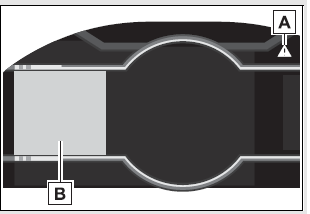
- Master warning light The master warning light also comes on or flashes to indicate that a message is currently being displayed on the multi-information display.
- Multi-information display Follow the instructions of the message on the multi-information display.
Warning messages
The warning messages explained below may differ from the actual messages according to operation conditions and vehicle specifications.
Warning buzzer
- In some cases, the buzzer may not be heard due to being in a noisy location or audio sound.
- If “Check Owner’s Manual” is displayed
- If the following messages are shown, follow the instructions, accordingly.
- “High Coolant Temperature”
- “Transmission Oil Temperature”
- If any of the following messages are shown on the multi-information display, it may indicate a malfunction.
- Have the vehicle inspected by your Toyota dealer immediately.
- “EyeSight OFF”
- “Headlights Disabled”
- “ABS”
- “Steering System”
- “Vehicle Stability Control”
- “Transmission”
- “Low Tire Pressure”
- “RAB Disabled”
- “BSD/RCTA Disabled”
- “Keyless Access System Disabled”
- “Auto Headlight Leveler Disabled”
- “SRH Disabled”
- If any of the following messages are shown on the multi-information display, it may indicate a malfunction. Immediately stop the vehicle and contact your Toyota dealer.
- “Brake System”
- “Check Engine”
- “SRS Airbag System”
Vehicle maintenance tips
If you have a flat tire
Your vehicle is not equipped with a spare tire but instead is equipped with an emergency tire puncture repair kit. A puncture caused by a nail or screw passing through the tire tread can be repaired temporarily with the emergency tire puncture repair kit.
WARNING
- If you have a flat tire
- Do not continue driving with a flat tire.
- Driving even a short distance with a flat tire can damage the tire and the wheel beyond repair.
- Driving with a flat tire may cause a circumferential groove on the side wall.
- In such a case, the tire may explode when using the emergency tire puncture repair kit, resulting in death or serious injury.
Before repairing the vehicle
- Stop the vehicle in a safe place on a hard, flat surface.
- Set the parking brake.
- Shift the shift lever to P (automatic transmission) or R (manual transmission).
- Stop the engine.
- Turn on the emergency flashers.
- Check the degree of the tire damage. A tire should only be repaired with the emergency tire puncture repair kit if the damage is caused by a nail or screw passing through the tire tread.
- Do not remove the nail or screw from the tire. Removing the object may widen the opening and disable emergency repair with the kit.
- To avoid sealant leakage, move the vehicle until the area of the puncture, if known, is positioned at the top of the tire.

A flat tire that cannot be repaired with the emergency tire puncture repair kit
- In the following cases, the tire cannot be repaired with the emergency tire puncture repair kit.
- Contact your Toyota dealer.
- When the tire is damaged due to driving without sufficient air pressure
- When the tire lost air pressure due to a crack or damage in the tire sidewall
- When the tire is visibly separated from the wheel
- When the cut or damage to the tread is 0.16 in. (4 mm) long or more
- When the wheel is damaged
- When 2 or more sharp objects, such as nails or screws, have passed through the tread on a single tire
- When there is more than one hole or cut in the damaged tire
- When the sealant has expired
Location of the emergency tire puncture repair kit and tools
- Towing eyelet
- Screwdriver
- Emergency tire puncture repair kits
- Wheel nut wrench
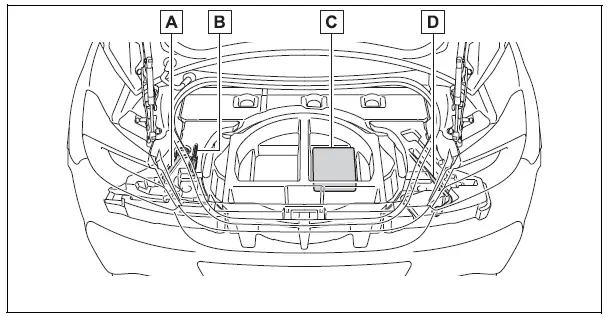
Emergency tire puncture repair kit components
- Sealant
- Sticker
- Quick reference
- Compressor

Compressor
- Compressor switch
- Hose
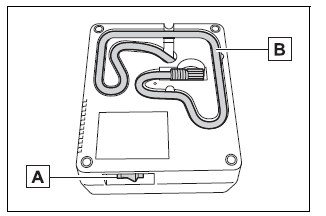
Sealant
- Hose
- Valve

Emergency tire puncture repair kit
Quick fixes for car problems
- The sealant has a limited lifespan. The expiry date is marked on the bottle. The sealant should be replaced before the expiry date. Contact your Toyota dealer for replacement.
- The sealant stored in the emergency tire puncture repair kit can be used only once to temporarily repair a single tire. If the sealant has been used and needs to be purchased, contact your Toyota dealer.
- The compressor is reusable.
- The sealant can be used when the outside temperature is from -22°F (-30°C) to 140°F (60°C).
- The kit is exclusively designed for the size and type of tires originally installed on your vehicle. Do not use it for tires that are a different size than the original ones, or for any other purposes.
- If the sealant gets on your clothes, it may stain.
- If the sealant adheres to a wheel or the surface of the vehicle body, the stain may not be removable if it is not cleaned at once. Immediately wipe away the sealant with a wet cloth.
- During the operation of the kit, a loud operation noise is produced. This does not indicate a malfunction.
- Do not use the emergency tire puncture repair kit to check or adjust the tire pressure.
- In extremely low temperatures -22°F to -4°F (-30°C to -20°C), the viscosity of the sealant increases and the sealant will flow more slowly
- In such temperatures, bring the sealant into the vehicle to warm it up before use.
- Note for checking the emergency tire puncture repair kit Check the sealant expiry date occasionally. The expiry date is shown on the bottle.
- Do not use sealant whose expiry date has already passed. Otherwise, repairs conducted using the emergency tire puncture repair kit may not be performed properly.
WARNING
- Caution while driving
- Store the repair kit in the trunk. Injuries may result in the event of an accident or sudden braking.
- The repair kit is exclusively only for your vehicle. Do not use repair kits on other vehicles, which could lead to an accident causing death or serious injury.
- Do not use a repair kit for tires that are different size than the original ones or for any other purpose. If the tires have not been completely repaired, it could lead to an accident causing death or serious injury.
- Precautions for use of the sealant
- Ingesting the sealant is hazardous to your health. If you ingest sealant, consume as much water as possible, then immediately consult a doctor.
- If sealant gets in the eyes or adheres to the skin, immediately wash it off with water. If discomfort persists, consult a doctor.
- If a person who is allergic to natural rubber comes in contact with the sealant, allergy symptoms may occur.
Taking out the emergency tire puncture repair kits
- Remove the luggage mat.

- Take out the emergency tire puncture repair kits.
Emergency repair method
- Shake the sealant bottle up and down several times and loosen the hose

- Connect the air compressor hose to the valve on the bottle.

- Valve
- Remove the valve cap from the valve of the punctured tire.

- Valve
- Cap
- Connect the sealant bottle hose by threading it on the valve.

- Turn the bottle upside down and tilt the bottle cap into the bottle holder of the air compressor.
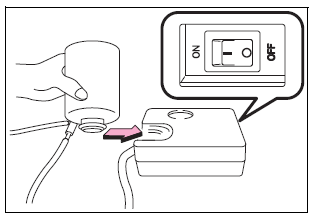
- Make sure that the air compressor switch is off.
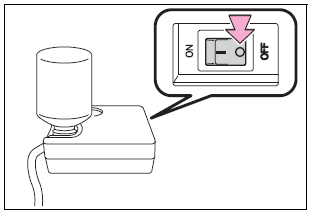
- Connect the compressor power plug to the power outlet.

- The engine switch must be in ACC.
- Power plug
- Power outlet
- The engine switch must be in ACC.
- To inject the sealant and inflate the tire, turn the compressor switch on.
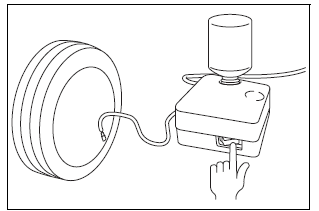
- Adjust the air pressure to the appropriate level (green zone of the air gauge). After the compressor starts to operate, the air pressure will temporarily rise to 44 psi (300 kPa, 3.0kgf/cm2 or bar) or higher. After about 30 seconds when all of the sealant is inside the tire, the air pressure will lower, representing the air pressure in the tire.

- While filling the tire with air, attach the speed limit label on the position shown in the illustration.
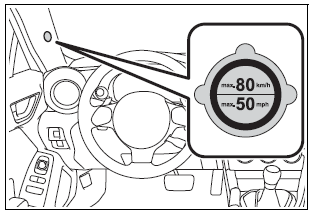
- Turn the air compressor power switch off when the air pressure reaches the green zone of the air gauge. Remove the power plug from the accessory power socket.

- With the compressor switch off, disconnect the hose from the valve on the tire and then pull out the power plug from the power outlet socket. Some sealant may leak when the hose is removed.
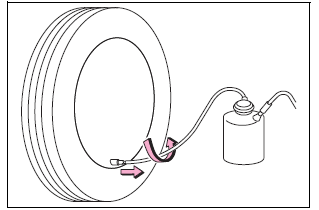
- Install the valve cap onto the valve of the emergency repaired tire.
- Connect the hose of the bottle to the valve of the bottle in a circular fashion to avoid leakage of the remaining sealant. The sealant may stain clothing.
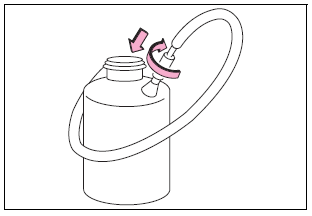
- Stow the kit back in the vehicle and drive your vehicle immediately for 10 minutes or 3 miles (5 km).
- After driving for 10 minutes or 3 miles (5 km), pull your vehicle over in a safe place and reconnect the compressor.
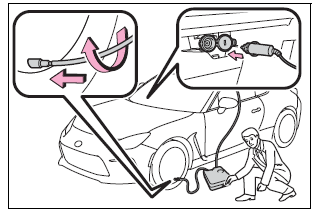
- Turn the compressor switch on and wait for several seconds, then turn it off. Check the tire inflation pressure.
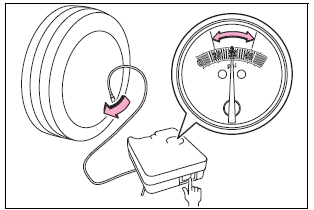
- If the air pressure is in the red zone of the air gauge, the kit did not successfully seal the puncture. In this case, please stop driving and contact your Toyota dealer.

- Taking precautions to avoid sudden braking, sudden acceleration, and sharp turns, drive carefully at under 50 mph (80 km/h) to the nearest Toyota dealer that is less than 124 miles (200 km) away for tire repair or replacement.
After a tire is repaired with the emergency tire puncture repair kit
- The tire pressure warning valve and transmitter should be replaced.
- Even if the tire inflation pressure is at the recommended level, the tire pressure warning light may come on/flash.
WARNING
- Do not drive the vehicle with a flat tire Do not continue driving with a flat tire. Driving even a short distance with a flat tire can damage the tire and the wheel beyond repair. Driving with a flat tire may cause a circumferential groove on the side wall. In such a case, the tire may explode when using a repair kit.
- When fixing a flat tire
- Stop your vehicle in a safe and flat area.
- Do not touch the wheels or the area around the brakes immediately after the vehicle has been driven. After the vehicle has been driven, the wheels and the area around the brakes may be extremely hot. Touching these areas with hands, feet, or other body parts may result in burns
WARNING
- Connect the valve and hose securely with the tire installed on the vehicle.
- If the hose is not properly connected to the valve, air leakage may occur or sealant may be sprayed out.
- If the hose comes off the valve while inflating the tire, there is a risk that the hose will move abruptly due to air pressure.
- After the inflation of the tire has been completed, the sealant may splatter when the hose is disconnected or some air is let out of the tire.
- Follow the operation procedure to repair the tire. If the procedure is not followed, the sealant may be sprayed out.
- Keep back from the tire while it is being repaired, as there is a chance of it bursting while the repair operation is being performed. If you notice any cracks or deformation of the tire, turn off the compressor switch and stop the repair operation immediately.
- The kit may overheat if operated for a long period. Do not operate the compressor continuously for more than 10 minutes.
- Parts of the kit become hot during operation. Be careful handling the kit during and after the operation. Do not touch the metal part around the connecting area between the bottle and compressor. It will be extremely hot. Do not attach the vehicle speed warning sticker to an area other than the one indicated. If the sticker is attached to an area where an SRS airbag is located, such as the pad of the steering wheel, it may prevent the SRS airbag from operating properly.
- Driving to spread the liquid sealant evenly Observe the following precautions to reduce the risk of accidents. Failing to do so may result in a loss of vehicle control and cause death or serious injury.
- Drive the vehicle carefully at a low speed. Be especially careful when turning and cornering.
- If the vehicle does not drive straight or you feel a pull through the steering wheel, stop the vehicle and check the tire. The tire may have separated from the wheel.
NOTICE.
- When performing an emergency repair
- Perform the emergency repair without removing the nail or screw that has punctured the tread of the tire. If the object that has punctured the tire is removed, repair by the emergency tire puncture repair kit may not be possible.
- The kit is not waterproof. Make sure that the kit is not exposed to water, such as when it is being used in the rain.
- Do not put the kit directly onto dusty ground such as sand at the side of the road. If the kit vacuums up dust etc., a malfunction may occur.
NOTICE
- Make sure to stand the kit with the bottle vertically. The kit cannot work properly if it is laid on its side.
- Handling the emergency tire puncture repair kit
- The compressor power source should be 12 V DC suitable for vehicle use. Do not connect the compressor to any other source.
- If gasoline splatters on the kit, the kit may deteriorate. Take care not to allow gasoline to contact it.
- Store the emergency tire puncture repair kit in the trunk. The kit may be thrown around during sudden braking and so forth, damaging the kit. Place the repair kit in storage to prevent it from being exposed to dirt or water.
- Store the kit in its assigned place out of reach of children.
- Do not disassemble or modify the kit. Do not subject parts such as the air pressure indicator to impacts. This may cause a malfunction.
- To avoid damage to the tire pressure warning valves and transmitters When a tire is repaired with liquid sealants, the tire pressure warning valve and transmitter may not operate properly. If a liquid sealant is used, contact your Toyota dealer as soon as possible. After the use of liquid sealant, make sure to replace the tire pressure warning valve and transmitter when repairing or replacing the tire.
If the engine does not start
If the engine will not start even though correct starting procedures are being followed consider each of the following points:
The engine will not start even though the starter motor operates normally.
One of the following may be the cause of the problem:
- There may not be sufficient fuel in the vehicle’s tank. Refuel the vehicle.
- The engine may be flooded. Try to restart the engine again following the correct starting procedures.
- There may be a malfunction in the engine immobilizer system. (P.79)
The starter motor turns over slowly, the interior lights and headlights are dim, or the horn does not sound or sounds at a low volume.
One of the following may be the cause of the problem:
- the battery may be discharged. (P.371)
- The battery terminal connections may be loose or corroded. P309
The starter motor does not turn over
The engine starting system may be malfunctioning due to an electrical problem such as an open circuit or a blown fuse. However, an interim measure is available to start the engine.
The starter motor does not turn over, the interior lights and headlights do not turn on, and the horn does not sound.
One of the following may be the cause of the problem:
-
One or both of the battery terminals may be disconnected.
-
The battery may be discharged.
-
Contact your Toyota dealer if the problem cannot be repaired, or if repair procedures are unknown.
Emergency start function
When the engine does not start, the following steps can be used as an interim measure to start the engine if the engine switch is functioning normally:
- Set the parking brake.
- Shift the shift lever to P.
- Turn the engine switch to ACCESSORY mode.
- Press and hold the engine switch for about 15 seconds while depressing the brake pedal firmly.
- Even if the engine can be started using the above steps, the system may malfunction. Has the vehicle been inspected by your Toyota dealer?
If you lose your keys
New genuine mechanical keys can be made by your Toyota dealer using another mechanical key and the key number stamped on your key number plate. Keep the plate in a safe place such as your wallet, not in the vehicle
NOTICE
When an electronic key is lost If the electronic key remains lost, the risk of vehicle theft increases significantly. Visit your Toyota dealer immediately with all remaining electronic keys that were provided with your vehicle.
If the fuel filler door cannot be opened
If the fuel filler door cannot be opened by pressing the center of the rear edge of the fuel filler door with the doors unlocked, the following procedure can be used to open the fuel filler door.
Opening the fuel filler door
- Remove the access cover at the right side of the trunk trim.

- Push the yellow lever to unlock the fuel filler lid.

If the electronic key does not operate properly
If communication between the electronic key and vehicle is interrupted (P. 112) or the electronic key cannot be used because the battery is depleted, the smart key system and wireless remote control cannot be used. In such cases, the doors can be opened and the engine can be started by following the procedure below.
When the electronic key does not work properly
- Make sure that the smart key system has not been deactivated in the customization setting. If it is off, turn the function on.
- Check if the battery-saving mode is set. If it is set, cancel the function.
NOTICE
In case of a smart key system malfunction or other key-related problems Take your vehicle with all the electronic keys provided with your vehicle to your Toyota dealer. Locking and unlocking the doors
Unlocking the door
Use the mechanical key to perform the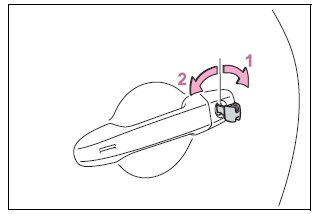
- Unlocks driver’s door
- Locks driver’s door
Starting the engine
- Vehicles with an automatic transmission: Ensure that the shift lever is in P and depress the brake pedal. Vehicles with a manual transmission: Shift the shift lever to N and depress the clutch pedal.
- Touch the area behind the lock button and unlock button on the electronic key to the engine switch.
- Firmly depress the brake pedal (automatic transmission) or clutch pedal (manual transmission) and check that is shown on the multi-information display.
- Press the engine switch. If the engine still cannot be started, contact your Toyota dealer.
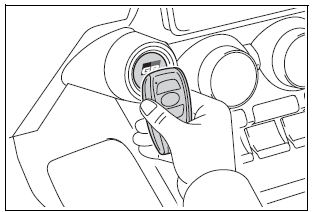
Stopping the engine
Vehicles with an automatic transmission: Shift the shift lever to P and press the engine switch as you normally do when stopping the engine. Vehicles with a manual transmission: Shift the shift lever to N and press the engine switch as you normally do when stopping the engine.
Electronic key battery
As the above procedure is a temporary measure, it is recommended that the electronic key battery be replaced immediately when the battery is depleted.
Alarm
Using the mechanical key to lock the doors will not set the alarm system. If a door is unlocked using the mechanical key when the alarm system is set, the alarm may be triggered.
Changing engine switch modes
Release the brake pedal (automatic transmission) or clutch pedal (manual transmission) and press the engine switch in step 3 above. The engine does not start and modes will be changed each time the switch is pressed.
If the vehicle battery is discharged
The following procedures may be used to start the engine if the vehicle’s battery is discharged. You can also call your Toyota dealer or a qualified repair shop.
Restarting the engine
- Confirm that the electronic key is being carried.
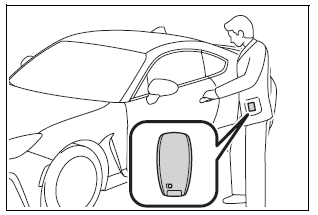
- Open the hood.
- Connect a positive jumper cable clamp to your vehicle and connect the clamp on the other end of the positive cable to the second vehicle. Then, connect a negative cable clamp to the second vehicle and connect the clamp at the other end of the negative cable to
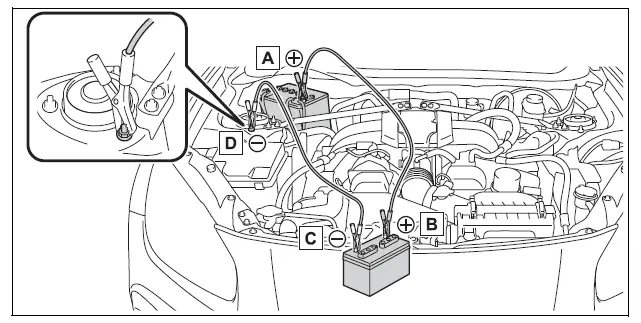
- Positive (+) battery terminal (your vehicle)
- Positive (+) battery terminal (second vehicle)
- Negative (-) battery terminal (second vehicle)
- Start the engine of the second vehicle. Increase the engine speed slightly and maintain it at that level for approximately 5 minutes to recharge the battery of your vehicle.
- Open and close any of the doors of your vehicle with the engine switch off.
- Maintain the engine speed of the second vehicle and turn the engine switch to IGNITION ON mode, then start the vehicle’s engine.
- Once the vehicle’s engine has started, remove the jumper cables in the exact reverse order from which they were connected.
- Once the engine starts have the vehicle inspected at your Toyota dealer as soon as possible.
Starting the engine when the battery is discharged
The engine cannot be started by push-starting.
To prevent battery discharge
-
- Turn off the headlights and the audio system while the engine is off.
- Turn off any unnecessary electrical components when the vehicle is running at a low speed for an extended period, such as in heavy traffic.
Charging the battery
- The electricity stored in the battery will discharge gradually even when the vehicle is not in use, due to natural discharge and the draining effects of certain electrical appliances. If the vehicle is left for a long time, the battery may discharge, and the engine may be unable to start. (The battery recharges automatically during driving.)
When the battery is removed or discharged
- Information stored in the ECU is cleared. When the battery is depleted, have the vehicle inspected at your Toyota dealer.
When removing the battery terminals
- When the battery terminals are removed, the information stored in the ECU is cleared. Before removing the battery terminals, contact your Toyota dealer.
Charging the battery
- The electricity stored in the battery will discharge gradually even when the vehicle is not in use, due to natural discharge and the draining effects of certain electrical appliances. If the vehicle is left for a long time, the battery may discharge, and the engine may be unable to start. (The battery recharges automatically during driving.)
When recharging or replacing the battery
- In some cases, it may not be possible to unlock the doors using the smart key system when the battery is discharged. Use the wireless remote control or the mechanical key to lock or unlock the doors.
- The engine may not start on the first attempt after the battery has recharged but will start normally after the second attempt. This is not a malfunction.
- The engine switch mode is memorized by the vehicle. When the battery is reconnected, the system will return to the mode it was in before the battery was discharged. Before disconnecting the battery, turn the engine switch off. If you are unsure what mode the engine switch was in before the battery discharged, be especially careful when reconnecting the battery.
- Make sure that the key is not inside the vehicle when recharging or replacing the battery. The key may be locked in the vehicle if the alarm is activated.
WARNING
Avoiding battery fires or explosions
- Observe the following precautions to prevent accidentally igniting the flammable gas that may be emitted from the battery:
- Make sure each jumper cable is connected to the correct terminal and that it is not unintentionally in contact with any other than the intended terminal.
- Do not allow the other end of the jumper cable connected to the “+” terminal to come into contact with any other parts or metal surfaces in the area, such as brackets or unpainted metal.
- Do not allow the + and – clamps of the jumper cables to come into contact with each other.
Do not smoke, use matches, or cigarette lighters, or allow open flame near the battery.
Battery precautions
- The battery contains poisonous and corrosive acidic electrolytes, while related parts contain lead and lead compounds. Observe the following precautions when handling the battery:
- When working with the battery, always wear safety glasses and take care not to allow any battery fluids (acid) to come into contact with skin, clothing, or the vehicle body.
- Do not lean over the battery.
- If battery fluid comes into contact with the skin or eyes, immediately wash the affected area with water and seek medical attention. Place a wet sponge or cloth over the affected area until medical attention can be received.
- Always wash your hands after handling the battery support, terminals, and other battery-related parts.
- Do not allow children near the battery.
NOTICE
When handling jumper cables
When connecting the jumper cables, ensure that they do not become entangled in the cooling fans or engine drive belt.
When closing the doors
While pushing the door glass towards the inside of the vehicle, slowly close the door. Because the side window open/close function linked to door operation will not operate, the window may interfere with the vehicle body, possibly scratching both the vehicle body and window or even shattering the window.
If your vehicle overheats
- The following may indicate that your vehicle is overheating.
- The engine coolant temperature gauge is in the red zone or a loss of engine power is experienced. (For example, the vehicle speed does not increase.)
- “High Coolant Temperature
- Check Owner’s Manual” is shown on the multi-information display.
- Steam comes out from under the hood.
Correction procedures
- Stop the vehicle in a safe place turn off the air conditioning system, and then stop the engine.
- If you see steam: Carefully lift the hood after the steam subsides. If you do not see steam: Carefully lift the hood.
- After the engine has cooled down sufficiently, inspect the hoses and radiator core (radiator) for any leaks
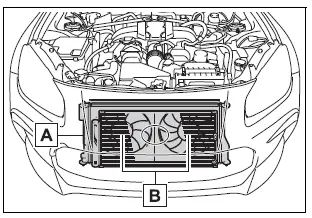
- Radiators
- Cooling fans
- The coolant level is satisfactory if it is between the “F” and “L” lines on the reservoir. Reservoir
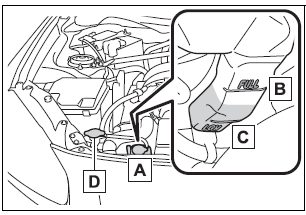
- Reservoir
- “FULL” line
- “LOW” line
- Radiator cap
- Add engine coolant if necessary.
- Water can be used in an emergency if engine coolant is unavailable.
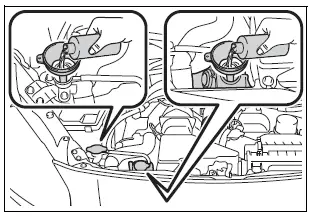
- Water can be used in an emergency if engine coolant is unavailable.
- Start the engine to check that the radiator cooling fan operates and to check for coolant leaks from the radiator or hoses.
- If the fan is not operating:
- Stop the engine immediately and contact your Toyota dealer.
- If the fan is operating:
- Has the vehicle been inspected at the nearest Toyota dealer?
WARNING
- When inspecting under the hood of your vehicle
Observe the following precautions.
Failure to do so may result in serious injuries such as burns.- If steam is seen coming from under the hood, do not open the hood until the steam has subsided. The engine compartment may be very hot.
- Keep hands and clothing (especially a tie, a scarf, or a muffler) away from the fans and belts.
- Do not loosen the radiator cap and the coolant reservoir cap while the engine and radiator are hot. High-temperature steam or coolant could spray out.
NOTICE
- When adding engine coolant
Wait until the engine has cooled down before adding engine coolant. When adding coolant, do so slowly. Adding cool coolant to a hot engine too quickly can cause damage to the engine. - To prevent damage to the cooling system
Observe the following precautions:- Avoid contaminating the coolant with foreign matter (such as sand or dust etc.).
- Do not use any coolant additives.
If the vehicle becomes stuck
Carry out the following procedures if the tires spin or the vehicle becomes stuck in mud, dirt, or snow:
Recovering procedure
- Stop the engine. Set the parking brake and shift the shift lever to P (automatic transmission) or N (manual transmission).
- Remove the mud, snow, or sand from around the rear wheels.
- Place wood, stones, or some other material under the rear wheels to help provide traction.
- Restart the engine.
- Shift the shift lever to D or R (automatic transmission) or 1 or R (manual transmission) and release the parking brake. Then, while exercising caution, depress the accelerator pedal
WARNING
- When attempting to free a stuck vehicle
If you choose to push the vehicle back and forth to free it, make sure the surrounding area is clear to avoid striking other vehicles, objects, or people. The vehicle may also lunge forward or lunge back suddenly as it becomes free. Use extreme caution. - When shifting the shift lever
Be careful not to shift the shift lever with the accelerator pedal depressed. This may lead to unexpected rapid acceleration of the vehicle that may cause an accident resulting in death or serious injury.
NOTICE
- To avoid damaging the transmission and other components
- Avoid spinning the wheels and depressing the accelerator pedal more than necessary.
- If the vehicle remains stuck even after these procedures are performed, the vehicle may require towing to be freed.
- When a warning message for the automatic transmission fluid temperature is displayed while attempting to free a stuck vehicle, immediately remove your foot from the accelerator pedal and wait until the warning message disappears. Otherwise, the transmission may become damaged.
FAQS
The kit usually includes a sealant and a compressor to temporarily repair minor tire punctures. Familiarize yourself with the contents and their usage.
The kit is designed for repairing small punctures. Larger or more severe damage may require professional assistance or spare tire installation.
The Emergency Start function is designed to jump-start your vehicle. Familiarize yourself with the procedure and the necessary precautions.
Ensure both vehicles are turned off, and follow proper cable connections (positive to positive, negative to negative).
Regularly check the battery’s condition, and avoid leaving electronic devices or lights on when the engine is off for an extended period.
Regular vehicle maintenance, including checking tire pressure and battery health, contributes to the proper functioning of emergency features.
Typically, the tire repair kit is for one-time use. If used, consult your Toyota service professional for a replacement kit.
In such cases, it’s advisable to contact roadside assistance or towing services for professional help.
The kit typically includes a sealant and a compressor. Familiarize yourself with the contents and their usage.
The kit is designed for repairing minor punctures. Larger or more severe damage may require professional assistance or spare tire installation.
The temporary repair is meant for short distances. It is advisable to visit a professional tire service as soon as possible for a permanent fix.
The kit is typically for one-time use. If used, consult your Toyota service professional for a replacement kit.
Useful Link
View Full PDF: Toyota 86 2022 User Guide
Download Manual: https://www.toyota.com/owners/resources/warranty-owners-manuals
Toyota 86 2022 Operating The Lights And Wipers User Guide
2023 Toyota GR86 Specs, Price, Features and Mileage (Brochure)


